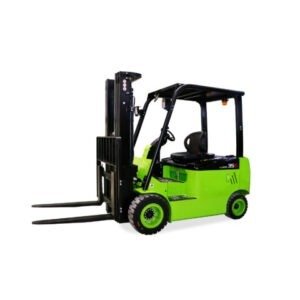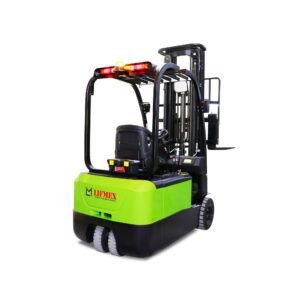From humble beginnings to advanced high-tech machinery, the evolution of forklifts has revolutionized the material handling industry. Once limited to basic functions, these indispensable tools have evolved to become powerful assets in warehouses and distribution centers around the world. In this article, we will explore the fascinating journey of forklifts, from their traditional roots to their modern technological capabilities.
Starting with rudimentary designs in the early 20th century, forklifts were primarily used for lifting and moving heavy loads. However, continuous innovation and technological advancements have transformed these machines into highly efficient and intelligent equipment capable of optimizing productivity and ensuring worker safety.
Today, forklifts are equipped with advanced features such as electric power steering, integrated cameras for efficient maneuvering, and sophisticated sensors for collision avoidance. These innovations have significantly improved operator comfort, reduced downtime, and increased overall efficiency.
Join us on a journey through time as we uncover the incredible evolution of forklifts and their impact on the modern workplace. Discover how these mechanical marvels have embraced technology to revolutionize the way we handle materials and boost productivity in the ever-evolving industrial landscape.
The limitations of traditional forklifts
The history of forklifts dates back to the early 20th century, when the need for efficient material handling in warehouses and factories became apparent. The first forklifts were simple machines, consisting of a platform or frame mounted on a set of wheels, with a lifting mechanism at the front. These early forklifts were powered by internal combustion engines, and their main purpose was to lift and move heavy loads.
One of the earliest forklift designs was the “Truck Tractor” developed by Clark Equipment Company in 1917. This primitive forklift had a capacity of 3,000 pounds and was operated by a single person. Over the years, various manufacturers introduced their own versions of forklifts, each with its own unique features and capabilities.
The rise of high-tech forklifts
While traditional forklifts played a crucial role in material handling, they had several limitations that hindered their efficiency and safety. One major limitation was the lack of maneuverability. Traditional forklifts had limited steering capabilities, making it difficult to navigate tight spaces and narrow aisles. This often resulted in accidents and damage to goods and infrastructure.
Another limitation was the reliance on internal combustion engines, which produced noise, emissions, and required regular maintenance. These engines were also less fuel-efficient compared to modern alternatives. Additionally, traditional forklifts lacked advanced safety features, such as collision detection systems, which increased the risk of accidents and injuries.
Key features of high-tech forklifts
The emergence of high-tech forklifts marked a turning point in the material handling industry. These advanced machines incorporated cutting-edge technologies to overcome the limitations of traditional forklifts and enhance productivity and safety in the workplace.
One of the key advancements in high-tech forklifts is the introduction of electric power steering. This feature provides precise control and maneuverability, allowing operators to navigate tight spaces with ease. Electric power steering also reduces operator fatigue, resulting in improved efficiency and productivity.
Another significant development is the integration of cameras and sensors into forklifts. These technologies enable operators to have a 360-degree view of their surroundings, eliminating blind spots and reducing the risk of accidents. Sophisticated sensors can detect obstacles and automatically apply brakes or adjust the speed of the forklift, further enhancing safety in the workplace.
Advantages of high-tech forklifts
High-tech forklifts come equipped with a range of advanced features that enhance their performance and efficiency. These features are designed to optimize productivity, improve operator comfort, and ensure workplace safety.
One of the key features is the integration of telematics systems, which provide real-time data on forklift performance, maintenance schedules, and operator behavior. This data can be used to identify areas for improvement, reduce downtime, and enhance overall efficiency.
Another important feature is the use of lithium-ion batteries, which offer several advantages over traditional lead-acid batteries. Lithium-ion batteries have a longer lifespan, faster charging times, and can be opportunity charged, eliminating the need for battery changes during shifts. This significantly reduces downtime and increases productivity.
The impact of high-tech forklifts on the industry
High-tech forklifts offer several advantages over their traditional counterparts. One of the main advantages is increased productivity. The advanced features and technologies in high-tech forklifts enable faster and more efficient material handling, reducing the time and effort required to complete tasks. This results in improved productivity and throughput in warehouses and distribution centers.
Another advantage is enhanced operator comfort. High-tech forklifts are designed with ergonomics in mind, providing comfortable seating, adjustable controls, and reduced vibration and noise levels. This improves operator satisfaction and reduces the risk of fatigue-related errors and injuries.
Furthermore, high-tech forklifts contribute to a safer working environment. The integration of cameras, sensors, and collision detection systems minimizes the risk of accidents and injuries. Operators can rely on these advanced technologies to navigate complex environments and avoid potential hazards.
Training and certification for operating high-tech forklifts
The introduction of high-tech forklifts has had a profound impact on the material handling industry. These advanced machines have revolutionized the way materials are handled, improving efficiency, safety, and overall productivity in warehouses and distribution centers.
With the ability to navigate narrow aisles and tight spaces, High-tech lifting machines have improved the use of available space, enabling businesses to increase their storage capacity This has led to significant cost savings and increased operational efficiency.
The integration of telematics systems in high-tech forklifts has also transformed maintenance practices. Real-time data on forklift performance and maintenance needs enable proactive maintenance, reducing unplanned downtime and costly repairs. This proactive approach to maintenance ensures that forklifts are always in optimal condition, minimizing disruptions to operations.
Types of Training and Certification:
OSHA Forklift Operator Certification:
This is the basic certification that all forklift operators must have, regardless of the type of forklift they use. It covers the general principles and practices of forklift safety, operation, and maintenance. It also includes topics such as workplace safety, hazard recognition, and emergency procedures. The certification process typically takes about one day to complete, and it consists of classroom training, hands-on instruction, and a written test. The certification is valid for three years, after which the operator must undergo a refresher course and a re-evaluation
Diesel Technology Certification:
This is a certification that is specific to forklifts that run on diesel engines. It covers the technical aspects of diesel engine operation, such as fuel injection, combustion, cooling, lubrication, and exhaust. It also covers the maintenance and repair of diesel engines, such as troubleshooting, diagnostics, and preventive measures. The certification process usually takes several months to complete, and it involves both classroom and laboratory training. The certification is recognized by the National Institute for Automotive Service Excellence (ASE)
Heavy Equipment Mechanics Certification:
This is a certification that is specific to forklifts that are classified as heavy equipment, such as telehandlers, rough terrain forklifts, and container handlers. It covers the mechanical aspects of heavy equipment operation, such as hydraulics, pneumatics, electrical systems, and transmissions. It also covers the maintenance and repair of heavy equipment, such as welding, fabrication, and alignment. The certification process usually takes several months to complete, and it involves both classroom and workshop training. The certification is recognized by the Association of Equipment Manufacturers (AEM).
Certified Forklift Technician (CFT) Certification:
This is a certification that is specific to forklifts that are equipped with high-tech features, such as sensors, cameras, GPS, and automation. It covers the advanced aspects of high-tech forklift operation, such as programming, calibration, and troubleshooting. It also covers the maintenance and repair of high-tech forklifts, such as software updates, hardware upgrades, and network connectivity. The certification process usually takes several weeks to complete, and it involves both online and on-site training. The certification is recognized by the Material Handling Equipment Distributors Association (MHEDA)
Introducing two types of electric forklifts that are available with Shabbir Enterprises
Electric Counterbalance Forklifts:
Electric counterbalance forklifts are the most common type of equipment, and they are suitable for a wide range of indoor and outdoor applications. They have a counterweight at the rear of the truck, which balances the load on the forks at the front. This allows them to lift and carry heavy loads without tipping over. Electric counterbalance forklifts are powered by batteries, which make them more energy-efficient, eco-friendly, and quieter than diesel or gas forklifts.
GET IT NOW
Electric Forklifts 3 Wheel:
Electric forklifts 3 wheel are a special type of equipment that have three wheels instead of four. They have two wheels at the front and one wheel at the back, which gives them a smaller turning radius and better maneuverability than four-wheel forklifts.
Electric lifting machines with three wheels are perfect for small spaces and thin corridors, where traditional lifting machines may not fit.
They are also powered by batteries, which make them more energy-efficient, eco-friendly, and quieter than diesel or gas forklifts.
GET IT NOW
The future of forklift technology
As high-tech forklifts become more prevalent in the industry, proper training and certification for operators are crucial. The advanced features and technologies in these machines require operators to have a comprehensive understanding of their functions and capabilities.
Training programs for operating cover topics such as equipment operation, safety procedures, maintenance, and troubleshooting. These programs ensure that operators are equipped with the necessary knowledge and skills to operate the machines safely and efficiently.
Certification programs provide official recognition of an operator’s competence in operating high-tech forklifts. Employers often require operators to be certified to ensure compliance with safety regulations and minimize the risk of accidents and injuries.
The innovation of lifting machines is not yet complete. As technology progresses, we can anticipate even more amazing improvements in the area of lifting machine technology
One area that holds great promise is automation. The integration of artificial intelligence and robotics into forklifts has the potential to revolutionize the industry further. Automated forklifts can perform tasks autonomously, reducing the need for human intervention and increasing efficiency and productivity.
Another area of future development is the use of alternative energy sources. As the world becomes more environmentally conscious, there is a growing demand for forklifts powered by clean energy. Battery technologies are advancing rapidly, and we can expect to see more forklifts powered by lithium-ion batteries or other sustainable energy sources in the future.
For further insights or to discuss your unique requirements, we invite you to connect with us Explore the unparalleled expertise and quality solutions that Shabbir Enterprises brings to the table, ensuring your lifting needs are met with precision and reliability


